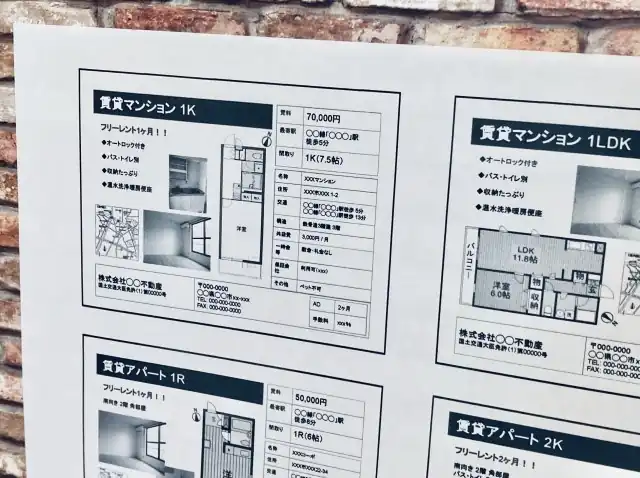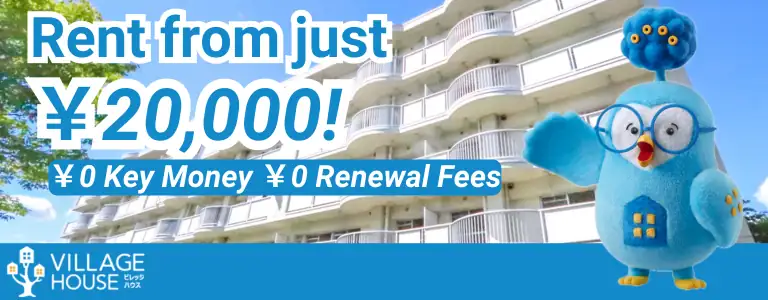Many of you might be wondering, “What kinds of floor plans and features should I avoid when choosing a rental property?” If you sign a lease without knowing what to look out for, you may end up regretting it.
In this article, we’ll introduce floor plans and potential red flags you should avoid in rental properties. Make sure to check our list to avoid renter’s remorse!
At Village House, we offer over 1,000 wonderful and affordable properties across Japan. If you’re searching for a new home, be sure to check out our website!
Seven floor plans to avoid when choosing a rental property

1. Small living space
It’s best to avoid properties with an extremely small living space, such as those with lofts that compromise the main room’s space. In a cramped room, it may be hard for friends or family to relax when they visit, and you might even have to give up on some nice furniture due to lack of space.
When viewing the property, it may seem spacious because there are no furniture or appliances installed. However, it is important to use a measuring tape to check how much free space will be left once furniture is installed.
2. Limited storage space
We do not recommend rental properties with limited storage space, as they can lead to clutter over time. For example, in properties without walk-in closets, it is difficult to find a place to store long clothes such as coats and suits. Hanging them in the room can look messy and collect dust.
Additionally, we also recommend properties with a spacious shoe cabinet. Without enough storage for shoes, you might end up storing boots, work heels, and casual sneakers in boxes around the room, taking up precious space.
3. Irregular layouts
Some properties have irregular floor plans, like triangular or trapezoidal rooms. These can be challenging to furnish and make it difficult to place standard-sized furniture, so take that into consideration if you are going to lease such an apartment.
However, if you enjoy unique layouts or are a minimalist with only carefully selected belongings, an irregularly shaped apartment might be an interesting option to consider.
4. Small kitchen space
A kitchen with a small countertop can make it hard to prepare meals, leaving little room for a cutting board or spreading out ingredients. This lack of space can make cooking at home inconvenient and feel like a chore. Even if you live alone, choosing a kitchen with enough countertop space to spread out ingredients and storage options for small spaces will make cooking at home more enjoyable.
5. Power outlets are difficult to access
Pay attention to the number and location of power outlets. If there are not enough outlets, you will end up with multiple power strips, which can be hazardous. Also, avoid outlets that are high up as they are hard to reach and difficult to use.
A good rule of thumb is to have at least two power outlets near the TV area and four in the kitchen. In addition, please be aware that due to wattage limitations, you may not be able to use extension cords.
6. Narrow entrance
It’s best to avoid properties with narrow entry doors since it will be difficult to bring in furniture and appliances. Older buildings, in particular, often have smaller entryways and corridors, which can prevent the delivery of large items like dressers, sofas, refrigerators, and washing machines.
Even if the passageway appears to be wide, if the door doesn’t open fully, or if there are obstacles like built-in umbrella stands, moving in can become tricky. Thus, be sure to check the width of the entrance before making a decision.
7. Poor layout flow
It’s advisable to avoid floor plans that make it difficult to move around comfortably. In apartments with one bedroom or more (1DK and larger), it’s easier to separate the living room and the bedroom. On the other hand, in studios or 1K apartments, the configuration of the kitchen or bathroom may be altered to save space, so it’s important to pay attention to how the floor plan is organized.
Potential red flags

When it comes to red flags, trying to avoid everything will cause you to go over budget. Prioritize your concerns and select a property accordingly.
Wooden rental houses
It is best to avoid rental properties with a wooden structure since they tend to have poor sound insulation, meaning you’re likely to hear everyday noises from neighboring rooms, such as TV noises or voices.
Thin walls
Even in properties with RC (Reinforced Concrete) or SRC (Steel Reinforced Concrete) construction, thin walls can still let you hear noise from neighboring rooms. When viewing the property, be sure to check the thickness of the walls. A good way to check is by knocking on the wall from inside the room—if it produces a high-pitched, light sound, it’s a sign to be cautious. Additionally, ask the real estate agent to walk down the hallway outside the property to see if the sound echoes.
Poor sunlight and ventilation
Rooms with poor sunlight and ventilation tend to accumulate moisture, leading to mold and dust mites. It is recommended to view the property between the morning and 2 PM, as this is the best time to assess the sunlight. Additionally, rooms with high humidity may show signs of mold or bubbled wallpaper, so be sure to check for these issues.
Low water pressure
Low water pressure can be frustrating, especially during baths or showers. If you can’t check the water pressure during the viewing, look at the water heater’s rating. For a person living alone, a water heater rated “16” or higher should be sufficient.
Old air conditioners
Check how old the model of the air conditioner is. Models older than 10 years old may consume more power while not being very effective. If the unit is outdated, consider asking if it can be replaced with a newer model.
Proximity of the trash disposal area
While it may seem convenient to have a trash disposal area nearby, it can lead to issues. Even if the doors are closed, insects can enter the room through vents or outdoor units. Additionally, if there are violations or delays in trash collection, especially during hot weather, it can lead to unpleasant odors.
Not using city gas
If the property uses propane gas, the usage fee will be higher than that of city gas. Generally speaking, propane gas tends to be about 3,000 yen more expensive per month than city gas. It is recommended to choose a rental property that is compatible with city gas whenever possible.
Read more: Average Gas Utility Bills for a Person Living Alone: Tips on How to Save!
Messy common areas
It is best to avoid rental properties where the shared areas are unclean and messy. In rental properties where the shared areas are messy, there is a high possibility that there is poor management or other tenants have bad manners. It is advisable to avoid properties where the garbage area, shared mailboxes, bicycle parking area, and parking lot are messy.
Key tips for choosing a rental property without regrets

Rent within 33% of your take-home pay
When searching for a rental property, aim for rent that’s about one-third of your monthly take-home pay. This rule of thumb not only makes it easier to pass rental screenings but also helps reduce the burden of living expenses. If you want to save more or are unsure about whether you will pass the screening, consider setting your rent budget at a quarter of your monthly take-home pay.
Within a 15-minute walk from the nearest station
Rent for properties within 5 to 10 minutes of the nearest station tends to be expensive. However, if you broaden your search to include apartments within a 15-minute walk, you will have more options and a higher chance of finding a suitable property. The distance will be around 1.2 km at most, so you won’t feel particularly inconvenienced.
Always attend an in-person viewing
Whenever possible, make sure to attend an in-person viewing of the property. If you live far away, you may have to rely on a virtual tour. However, in order to avoid regretting your decision after moving in, it is best to see the apartment firsthand to ensure that it meets your expectations.
Communicate your dealbreakers to the real estate agent
To find a property that closely matches your preferences, clearly communicate your non-negotiable conditions to the real estate agent. For example, it is important to narrow down your non-negotiable conditions, such as “I would like a property on the second floor or higher, 15 minutes from the nearest station, separate bathroom and toilet, and rent up to X million yen.”
At Village House, we offer over 1,000 rental properties across Japan. If you’re searching for a new place to live, please feel free to reach out to us!
Related articles:
- Which Apartment Layout Is Suitable For Living Alone? Find Out Which Room Type Is Best For You!
- What is the Layout of a Studio Apartment? Advantages, Disadvantages, and Differences to 1K and 1DK Explained!
- Suitable Apartment Layouts for Couples – Find Out Which is Best for You and Your Partner!
- Suitable Apartment Layouts for a Family of Three – Find Out Which Is Best for You!
- Kinds of Apartment Layouts

Hello, I’m Machiko Doi, a freelance writer who writes about housing and living in Japan.
I live in an 80-year-old house that I inherited from my grandparents along with my two shelter cats and daughter.
We live a relaxed life while repairing the house.
I like to cook vegetables from the garden and fresh fish caught by my father, and enjoy them with cold beer on a hot day or hot sake on a cold day.



